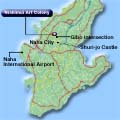|
The U.S. military's extremely prompt measures on Okinawan refugees
and cultural protection/promotion policy must be noted during this period.
This reflects the U.S. military's policy which was established from the
perspective of U.S. Navy officers who had strong academic background.
Captain Hannah, who had profound knowledge of Asian history and
culture, was aware that U.S. occupation on Okinawa would free Okinawan
people from Japanese Imperialism. He used cultural protection/promotion
policy as a strategy to carry out smooth administrative operations.
Establishing Okinawan identity by emphasizing Okinawa's unique cultural
characteristics was needed in order to sever Okinawa from the rest of Japan. The measure was sole positive side of U.S. military administration on Okinawa.On the other hand, it may have weakened political/social expression.
|
|
On April 5, 1945, Chester W. Nimitz, the Commander in Chief and
Fleet Admiral of the United States Navy for the U.S. Pacific Ocean Areas,
issued proclamation Number 1, which ended all Japanese administrative
authority on Okinawa and initiated United States Military Government
administration of the Ryukyus. On August 15, the military government
proposed to establish an Okinawan Advisory Council in Higaonna, Ishikawa
City.
The main objective of the establishment of the council was to open a
way for discussion between the United States Military Government and
Okinawan society. The council created twelve executive departments. Arts
and Monuments was one of them. James Watkins, Lieutenant Commander of the U.S. Navy, and Willard Hannah, Captain of the U.S. Navy, were
enthusiastic in protecting and promoting Okinawan culture. Under their
supervision, artists were gathered in Higaonna. They also restored a
residential house to a museum, organized traditional Ryukyuan dance shows
and art exhibitions; and collected cultural assets. Soon Art Section was
established under Arts and Monuments Department, and many artists were
hired as art technical advisors. Their work included: human resource development, organizing exhibitions, making Christmas cards, painting local landscape and people's daily life based on requests from the U.S. military personnel. In 1946, museums were founded in Ishikawa and Shuri.
In 1948, as military government were relocated to the south, Arts and Monuments Department was abolished, and artists were released from their
responsibilities. They moved to Nishimui, Shuri and constructed their studios and residential houses there, which later became Shuri Art Colony.
The artists living in Shuri Art Colony included: Keiichi Yamamoto,
Yasutaro Kinjo, Masayoshi Adaniya, Aijun Nadoyama, Kohya Oshiro, Ken Yabu,Seikichi Tamanaha, and Itoku Gushiken. Those artists' work such as family
portraits and landscapes were quite popular among U.S. military personnel
and sold very well. Those art works were exchanged with cigarettes most of
the case and later artists sold cigarettes at the local market to double money.
2. Establishing 'Okiten, Okinawa Art Exhibition'
In 1949, the first annual Okinawa Art Exhibition, which changed its
name later to 'Okiten', was held. Okiten was organized as an event
celebrating the first anniversary of the foundation of Okinawa Times. Tokue
Omura won the Okiten Prize that year. He painted quonset huts which most people lived at that time in his work, but the work did not survive.
|



 |